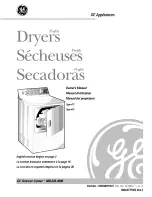
S
PECIAL LAUNDRY TIPS
Please follow the care label or manufacturer’s instructions for drying special items. If care label instructions are not available, use the fol-
lowing information as a guide.
Choose heat for the type fabric used. Dry one double or two single spreads at once. (Chenille and tufted spreads
will shed lint and should be dried along. New spreads will contain loose lint.) Tumble new spreads on AIR FLUFF
setting before washing to remove loose lint. (These spreads may be dried completely.)
DELICATE or AIR FLUFF cycles. If the manufacturer recommends drying the blanket in the dryer, follow the “Wool”
instructions below. Do not stretch the blanket because of the wiring. Some electric blankets may have insulation on
the thermostats or on the wiring which will not withstand dryer heat. Do not dry in dryer unless the blanket manu-
facturer says it can be done.
DELICATE or AIR FLUFF cycles. Some of these blankets are fluffy and will shed lint. Tumble on AIR FLUFF set-
ting before washing to remove loose lint. Use a gentle wash method, then dry in dryer until just dry. The lint filter
may need to be cleaned during the drying.
AUTO DRY REGULAR cycle.
Agitation and tumbling contribute to the shrinkage and felting of wool. We cannot guarantee that wool will not shrink.
However, if care is taken and the blanket manufacturer’s instructions are followed,satisfactory results should be
obtained. Wash by the soak method with as little agitation as possible. After washing, stretch blanket gently in both
directions. Use approximately five dry bath towels and place them between folds in blanket. This will "cushion” it to
lessen the tumbling. Set dryer for 20 minutes on the TIME DRY cycle. Use REGULAR heat setting, if it is available
on your dryer. Check blanket when timer reaches 10. Wool blankets must be removed from the dryer when damp.
Stretch gently to shape and finish drying over two clotheslines or in a flat position.
Choose heat and cycle for fabric. Filling and cover must be completely washable. Old quilts may be too fragile to
machine wash or dry. Quilts filled with cotton may become lumpy. Quilting should be close together. Remove from
dryer slightly damp and stretch gently to shape. Quilted articles may shrink if over dried.
Material in mattress pads is made of either cotton or synthetic fibers. Read fiber content label, found on your mat-
tress pad, to determine what type of fiber was used to manufacture the pad. READ AND CAREFULLY FOLLOW
the fabric care instructions supplied by the mattress pad manufacturer. Some pads made of synthetic fibers are very
heat sensitive. These pads can be flammable if over-heated or over-dried. TO AVOID A FIRE HAZARD, DO NOT
OVER-DRY mattress pads. Remove pads from the dryer while they are still damp.
Choose heat for fabric. Close zippers. Dry one couch cover, two chair covers or five or six pillow covers at one time.
Remove from dryer when slightly damp. Press pleats if necessary and replace on furniture immediately. Stretch fab-
rics and knits should be dried completely so they will fit snugly when replaced on furniture.
Ticking must be strong and seams secure. If in doubt, sew pillow into a case or use a zippered pillowcase to pre-
vent feathers from coming out. After washing, shake pillow to fluff feathers. Dry one large or two smaller pillows.
Use TIME DRY cycle. Use LOW or MEDIUM heat setting if it is available on you dryer. Shake and reposition pil-
lows several times during drying. Pillows must be dry in the center to prevent mildew. Drying may take two hours
or longer. Reset dryer timer if necessary. The odor of wet feathers is not pleasant. However, the odor will disappear
once the pillows dry.
Follow manufacturer’s directions.
Do not dry in the dryer.
AUTO DRY REGULAR or TIME DRY cycles. Remove damp items for ironing or dry completely, then steam iron.
DO NOT DRY IN THE DRYER unless recommended by the manufacturer. Fiberglass may shred. Particles may
remain in the dryer and rub off on the next load. This could irritate the skin. “Beta” fiberglass may be dried in the
dryer if recommended by the manufacturer.
DELICATE or AIR FLUFF cycles. Allow room for tumbling to prevent wrinkling. Delicate or sheer curtains must be
dried by themselves so they will not be snagged by hooks or crushed by other clothes in the load. Some sheer cur-
tains are heat sensitive. Dry 10 minutes only, plus the cool down period. Remove from dryer immediately and hang.
If the dryer has been heated from a previous load, AIR FLUFF setting may be sufficient.
Remove hooks and weights before washing. Choose heat for fabric and allow space in the dryer for tumbling. Some
draperies may be removed when slightly damp and hung immediately. Lined draperies should be dry-cleaned
because they have a tendency to pucker.
Bedspreads
Blankets
Quilts
Mattress Pads
Slip Covers
Pillows
Curtains
Draperies
Electric
Synthetic Fibers
Thermal Cotton
Wool
Feather and
Down-Filled
Fiber-Filled
(polyester)
Foam Rubber
Cotton
Fiberglass
Synthetic Fibers
8






























